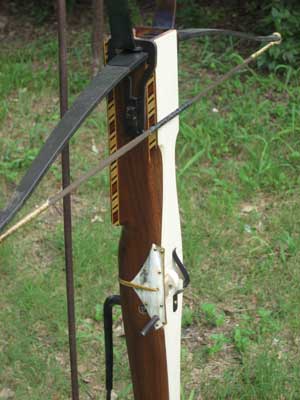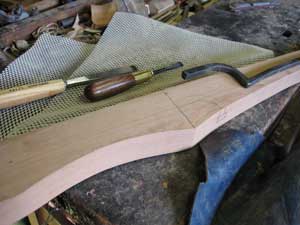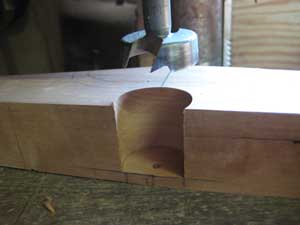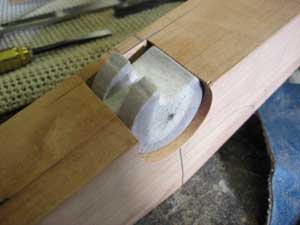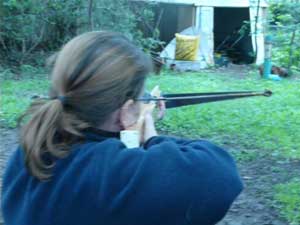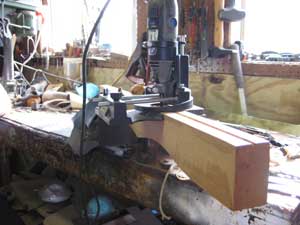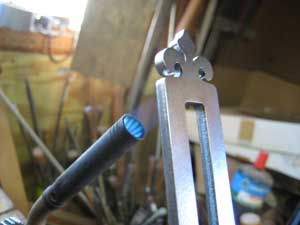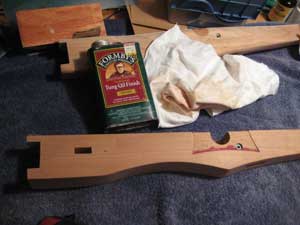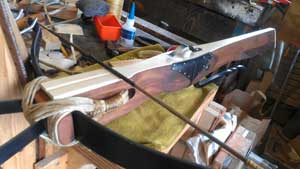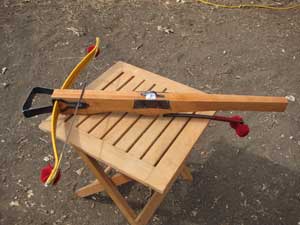
A few years ago, Maryellen Burdwood Porter sometimes shot hand bows as a hobby, and especially loved the old wooden ones. While living in San Francisco, she and a friend would “go down to Golden Gate Park and kill a few haybales.” Then, when she got arthritis in her shoulders, shooting hurt and “it wasn’t fun anymore” — until she tried a wooden crossbow at a Renaissance fair.
She wanted to order one, but had difficulty finding anything but fiberglass crossbows meant for hunting. Finally, shortly after moving to Round Rock, Texas, she found David Watson of New World Arbalestwho could make her a wooden crossbow. His shop was also 15 minutes away, in Austin, and he invited Maryellen to come over and observe.
Maryellen watched him make the bow, and watched apprentices come and go in the shop. When her order was finished, “The moment he finished making the bow, I put it in my truck and took it home; when I got to my house, I called him from home and said, ‘I want to be your apprentice.'”
Maryellen already had some woodworking experience: back in her late teens and early 20s, she worked with family friend Tim Brown in North Conway, New Hampshire, operating an “ancient spindle carving machine” that could carve 18 forms simultaneously. They made many duck decoys that were sent out to artists for painting, then sold through L.L. Bean. They also made other projects, like small boxes from oak pallets.
“I learned to love wood through Tim Brown,” Maryellen said. “I wanted to get back to it, but I never had the opportunity.” Instead, she used the money from her woodshop work to pay for college, and had a variety of jobs over the years, including as a San Francisco bike messenger and as an organic landscape gardener.
When she began apprenticing at New World Arbalest, “I got to be with wood dust again, and with the bows, and play,” Maryellen said. “I get to go to work and be covered in wood dust and make clean, straight lines in wood, shaping wood with spokeshaves and planers and raspers.”
One of those tasks is shaping the tiller portion of a bow. Also known as the “butt,” it’s the “handle” portion, somewhat equivalent to the stock of a gun. For this portion, “you have a lot of leeway,” Maryellen said. “Sometimes it’s plain, straight ones, like our Western European bows; sometimes it is a Germanic, or Finnish, shape, which are rounded, with beautiful sculpted lines.”
With some other parts of a bow, however, “There’s no leeway at all,” she said. “It has to be exactly precise. When you drill in the side of a bow and put in a socket to put in the nut [also known as the “roller release”], the socket has to be perfectly square so that the nut will release the string correctly. The prod, or bow part of the crossbow [the metal spring] must fit into the prod socket that is cut into the stock at the nose. This socket must be cut into the wood precisely, or the angle of the prod will be incorrect, and then the string that is attached to the prod could be either too high — and not resting lightly along the deck of the tiller — or too low — and pressing too hard into the deck. Either of these will not allow the bolt to fly correctly when shot. And if it doesn’t shoot well — it’s a ‘wallhanger.'”
Maryellen doesn’t like to make wallhangers. “I get the glove out and shoot every single bow that I’ve done to test it. They are decorative — but, first, they work,” she said.
The New World Arbalest shop sells around 10 crossbows that are relatively correct copies of types from the Middle Ages, with customers coming from places like the Society for Creative Anachronism [SCA] and those interested in Western martial arts. In her first couple of years there, “The SCA people would say, ‘We can’t take that out on the field [for reenactments]; it’s too beautiful,” Maryellen said. “‘I’m like, ‘No! That’s what it’s for!’ So I had to ramp back my creativity and make them a little less ornate. That’s kind of hard.”
In the last couple of years, however, she’s moved in a different direction. While David, whom Maryellen describes as “a history buff; he’s forgotten more than I’ll ever learn” is not particularly interested in making accurate historical reproductions, Maryellen is. “My woodworking skills exceed his, and in the last two years I’ve been looking at how they were made 400 to 500 years ago. Then I can make them fancy and beautiful with bone and staghorn inlay.”
Recently, for instance, she’s been commissioned to make a reproduction of the crossbow of Ulrich V of Württemburg, a piece that’s currently in the Metropolitan Museum of Art. She’s been talking to the curator regarding measurement and materials and, while she currently can’t do the ornate carvings, “I’ll be adding that to my skill set and teaching myself in the next couple of years,” Maryellen said.
Already, Maryellen has a crossbow in the Florida Musem of History. They wanted something to represent the crossbows found in a recovered shipwreck of a 16th century Spanish galleon, discovered in the 1970s around San Padres Island. “These were Spanish bows, long and narrow, stacked up on the bottom of the ship, the equivalent of AK-47’s,” Maryellen said. “Sailors would run and get these for ship defense.”
“My master was allowed to go and handle” the artifacts, “white gloves and all that,” to glean information about them, ‘ Maryellen said. “Now, whenever we get an order for a Padres Island bow, I get to make it, because I’m good at it, and enjoy it.”
While the Padres Island bow for the museum was made from oak, most of the still-existing historical bows are made from fruitwoods, such as pear or cherry, as well as walnut, and that’s what Maryellen uses in her work, as well. Those extant crossbows, however, are mostly bows that belonged to nobles. Those used by regular military infantries were stored in armories and didn’t survive as well.
History also explains portrayals in current media, like the TV show “Once Upon a Time” (for which Maryellen made a crossbow, although she doesn’t know which episode it’s on). “The bad guys have crossbows, and the good guys have handbows,” she said. “Crossbows have such a bad rep.”
Historically, “Long bowmen started training at age six. They were considered a resource, and were kept well-fed,” she said. “Then, when crossbows came along, anybody could grab a crossbow and be OK with it in a week. At some point, any infantryman with a crossbow could shoot a knight off a horse, which was anathema to the code of chivalry.” Crossbows then went out of style by the late 1500s, replaced by muskets and such items, and were used only for specialized hunting applications by the gentry.
This year, they’re making a reappearance in popular culture, with movies like The Hunger Games, Snow White and the Huntsman and Brave. When she watches such shows, Maryellen said, she’s looking to see if the actors handled the bow correctly: “I’ll think ‘they’re going to shoot themselves in the foot’ or ‘they’ll hurt their hand if they do that.'”
She also, of course, notices construction of the bows — such as one that appeared in a 1980s film called Ladyhawke that had two prods [the limbs of the bow, attached to the crosspiece] “one on top of each other, which is completely impossible.” She and David Watson are still rejecting requests from people who want them to build a Ladyhawke bow.
Several of their own bows have, however, made their way to Hollywood. Before Maryellen worked for David Watson at New World Arbalest, he was commissioned to make two or three bows for “Buffy, the Vampire Slayer,” and Maryellen has made a bow for Spike TV’s “Deadliest Warrior.” “They wanted a knight to fight a pirate to see who would win,” she said.
Most recently, she was commissioned to make bows for a movie currently titled Seventh Son, which stars Jeff Bridges and began filming in March. Maryellen made three horse bows [for mounted archery] and six to eight Western bows “and sent them off to the movies.”
As for her own collection, Maryellen currently owns three crossbows and is making three more — one near completion, and two more that are currently just stock she has cut out. She also has “two or three other fantasy bows, where I just know what I want to make.” As one of about 20 artisans worldwide currently recreating historic bows, “There’s so many bows to make, so little time…”
